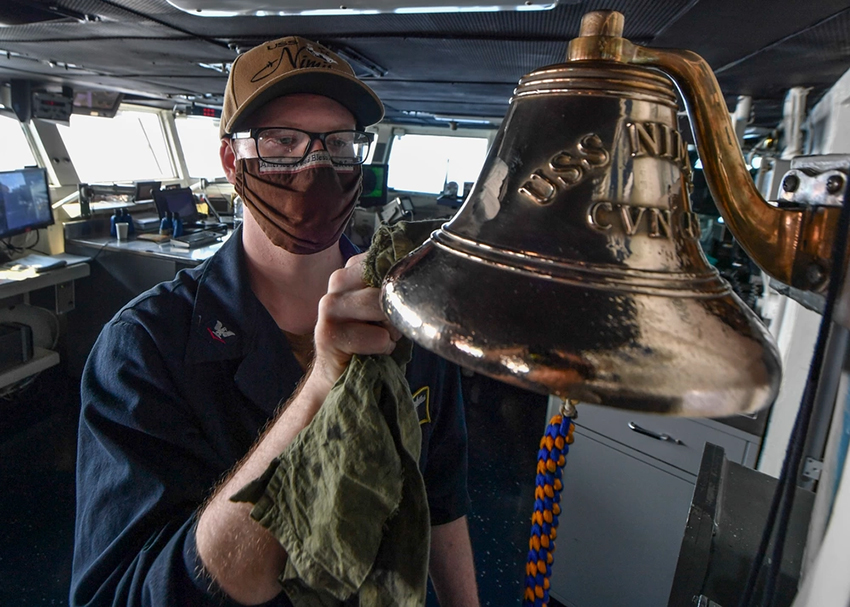The U.S. Navy commands the seas far beyond America’s shores. Whether sailing in support of joint force operations, maintaining maritime security, or bolstering regional and coalition partners, the U.S. Navy is the largest and most powerful navy in the world.
The Navy also runs a tight ship. A lot can go terribly wrong, terribly quickly, when you’re in the middle of an ocean or in the middle of a war. The exactitude with which sailors clean and organize their ship facilitates an orderly and efficient life at sea. No detail is overlooked – from the crisp corners of a well-tucked bed to the spotlessness of the brass ship’s bell.

Image: Boatswain's Mate 3rd Class David Crisp, from Grays Lake, Ill., shines the ship's bell in the bridge of the aircraft carrier USS Nimitz (CVN 68) on Oct. 5, 2020. Nimitz, the flagship of Nimitz Carrier Strike Group, is deployed to the U.S. 5th Fleet area of operations, conducting missions in support of OIR, and maritime security operations alongside regional and coalition partners in the Arabian Gulf. Courtesy: Mass Communication Specialist 3rd Class Elliot Schaudt, U.S. Navy.*
Ship’s bells have accompanied the U.S. Navy and merchant fleet for centuries, serving both functional and ceremonial uses. Bells are typically mounted in a prominent position on an upper deck to signal crew and passengers, broadcast the time, announce whether an important personage or officer had boarded the vessel, or indicate the position of the ship in heavy fog. To honor a sailor who has died, a bell is tolled resolutely eight times – a pattern that denotes the end of the watch.
Traditionally, the ship's name and year it was launched are engraved or cast onto the surface of the bell. A ship’s bell can even be used as a makeshift baptismal font. In the event of a shipwreck, when more vulnerable materials like wood are swept away or degrade into the ocean floor, the bell often provides the only positive means of identification.

Image: U.S. Navy Aviation Support Equipment Technician 3rd Class Thomas Kennard polishes the ship's bell aboard the amphibious assault ship USS Bataan (LHD 5) on Dec. 11, 2013, in the Atlantic Ocean. The Bataan and the embarked 22nd Marine Expeditionary Unit were conducting a composite training unit exercise in preparation for a scheduled deployment. Courtesy: Mass Communication Specialist Michael J. Lieberknecht, U.S. Navy.*
A ship’s bell is an integral part of the vessel and a pride among the crew. As such, it is treated with utmost care and respect. But how, with so much moisture and salt bombarding the bell’s surface, do sailors manage to keep the brass ship’s bell shiny and clean? It’s possible with a little bit of effort and some staples from the galley pantry.
Of course, if you happen to have a professional brass polish, then any tarnish will buff right away. If you don’t? Sailors are known for their resourcefulness and, in a pinch, can whip-up a paste with lemon and salt or baking soda. The key is a bit of acid and a gentle abrasion.

Image: Boatswain's Mate Seaman Jordan Howard, from Pittsburgh, shines the ship's bell during cleaning stations aboard the aircraft carrier USS George H.W. Bush (CVN 77) on July 25, 2018. The ship is in port in Norfolk, Virginia, conducting routine training exercises to maintain carrier readiness. Courtesy: Mass Communication Specialist 2nd Class Joseph E. Montemarano, U.S. Navy.*
First, make sure the bell is solid brass and not brass-plated or an alloy of other base metals. Many ship’s bells are cast in brass, but larger ships often boast heavier bronze bells. If brass, halve a lemon and sprinkle table salt or baking soda on the cut side, and then rub, rub, rub! These can also be combined as a separate paste and buffed on the bell with a soft cloth.
In no time, the brass bell will be sparkling with the reflection of sun and sea – the pride of all who hear the rich and resonant tolls.
Cover image: Seaman Recruit Marcel Cochran shines the ship's bell aboard USS Normandy as the ship prepares to head into port after a two-day underway to prepare for inspection and survey at the end of July 2009. Courtesy: U.S. Navy.*
*The appearance of U.S. Department of Defense (DoD) visual information does not imply or constitute DoD endorsement.



